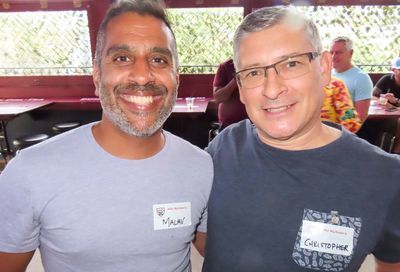Forever Annie's
The steakhouse that transformed 17th Street
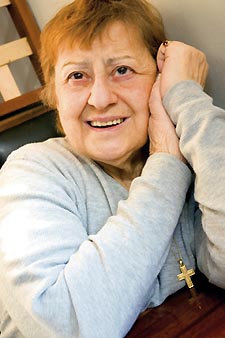 |
Some say it’s a landmark. Some say it’s an institution. Some call it a part of Washington’s gay identity. Whatever Annie’s Paramount Steakhouse is, there’s one thing it ain’t — pretentious. Between the menu and the staff, this anchor on 17th Street exudes comfort. And it’s been doing it for more than 50 years.
Annie Kaylor, 78, personifies the attitude of her namesake restaurant. Sitting in a booth by the bar, she’s brought some prepared notes to help her find the words to describe Annie’s — handwritten on her personalized Ziggy stationery from home. It makes you want to hug her or call her ”Momma.” Plenty do.
”Dining out at Annie’s is definitely a homey atmosphere,” she reads. Sidney, her husband of 40 years sits across the aisle at the bar. Her sister, Sophie, is there, too. They’ve all worked at Annie’s at one time or another.
”No one is treated better than anyone else. We are all accepted. It’s a fun environment. To say the least, the food is great and basic. It’s a fun experience in that there are no strangers where you go to Annie’s,” she says. “Our customers know we care about them. This means the world to us. The love is there. The love comes from the man who built this restaurant, by the name of George Katinas.”
Post-War Restaurant
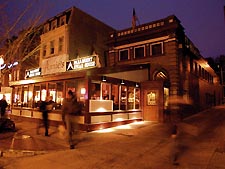 |
George is Annie’s older brother. At 84, he still lives in the area, but he’s excused himself from the business. It’s a well-earned break since opening the original Paramount Steakhouse — minus the ”Annie’s” moniker — a block down the street in 1948, in the building that now houses JR.’s Bar & Grill.
Although born in New York, George Katinas, like Annie, grew up in Northwest D.C. Their father, a Greek immigrant, was a fruit vendor in the neighborhood, working in the shadow of the Tivoli Theatre on 14th Street NW. World War II took George Katinas away from Washington, landing him on the battlefields of Europe. During the war, he served in the Army Signal Corps.
Serving in Europe afforded George the opportunity to make his way back to the Katinas family’s Greek roots on the island of Naxos. Katinas family lore includes the sad story of how he arrived too late to meet his grandmother, who had died a week earlier.
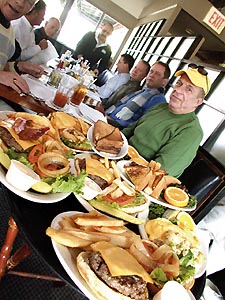 |
Thankfully, the Katinas story is otherwise short on tragedy. George made it home safe and sound, ready to join the rest of America in putting the war behind him and getting on with his dreams. With a little help from his parents, he realized his dream of starting a restaurant.
”The old place was actually more a beer type place,” says Annie of the original Paramount Steakhouse at 1519 17th Street NW. ”They called it a beer joint, though he didn’t like people calling it that. He wanted to make it something that was food and a bar.
”My brother wanted everybody to come,” she continues. ”He didn’t want a set thing. He wanted everyone to be treated equally. Today, we have people that come in who are straight and just love it here. When you come in here, you don’t feel like you’re in a restaurant. You’re just comfortable. It’s a friendly, nice place, and it’s got good food.”
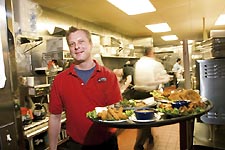 |
Indeed, people did come. The steakhouse was a success, and even spawned two other restaurants for a time — one downtown, the other in Georgetown. As those restaurants came to an end, so did George Katinas’s time in the kitchen. From a self-taught butcher who prepared his own meat and began a successful restaurant, to an at-home retiree, Annie says her brother had to step aside as the restaurant evolved with the times.
”He won’t come back here,” she says. ”He was a really dedicated man. He’s a very precise person, and he just couldn’t deal with the changes. They just weren’t him. So he turned the restaurant over to his sons. He loves for me to tell his sons what to do.”
Annie Onboard
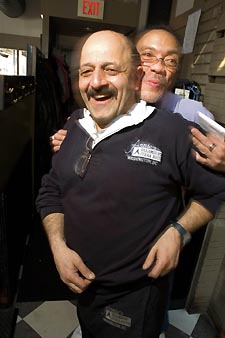 |
George’s precise nature was something he shared with their sister, Sue Stouts. The similarity was evident behind the bar, Annie on one end, Sue on the other.
”I started working here in 1952. [Sue] started in ’53. We ran the night shift,” Annie explains. ”My sister had a big, big role here. We both worked together. Her and I would work the bar at night. Customers who came in for her, they were very dignified and nice. They were gay. But the ones who came in for me were all crazy. My brother would say, ‘You can tell when Annie’s working — look at this place!’
”Sue’s side was very dignified. Everything had to be a certain way. I wasn’t allowed to pass the line. She’s been gone about eight years now. People loved her.”
As for gay people who started frequenting the Paramount Steakhouse shortly after it opened, Annie says she was unaware.
”When the gays would come in, we wouldn’t know they were gay,” she says. ”We just noticed that every time you turned around, we’d be filling up with guys and filling up with guys. It was a gradual thing without us even being aware of it….
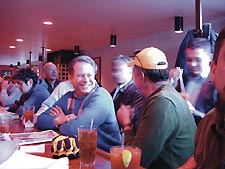 |
”One of the things that I want to get across is that we’re called a landmark for the gay community. Back in the ’50s, the gays started coming in. I had these waitresses that were all mothers, and they used to treat them very nice. We didn’t even know they were gay. They would just pass the word around how nice we were, and how you got a good steak.”
At the time, says Annie, the neighborhood was even more residential than it is today. Local boarding houses, along with the welcoming attitude, may have contributed to the gay mix. ”There was a hotel, like a rooming house,” she explains, remembering the neighborhood. ”Most of those people would come into the restaurant at night to eat and have a beer. You had the Irishmen, the Greeks, Italians — all different types of nationalities around the neighborhood. And you had a lot of construction workers in the rooming houses.”
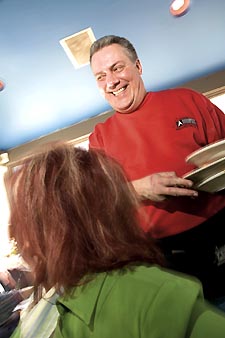 |
As gay Washingtonians and others continued to make their way to the steakhouse, George Katinas opened the Georgetown and downtown branches. The manager of one of these new restaurants wanted to personalize his restaurant by adding his own name to his Paramount outlet. George allowed it, says Annie, but only after drafting her to be the face of the original Paramount on 17th Street.
”He said, well, if you’re going to have your name on that, I’m going to have my sister’s name on this one,” she says, with some apparent embarrassment. ”’Why are you doing that?’ I said.’ And it was called Annie’s Paramount Steakhouse. The change was in the ’60s — 1962? Somewhere around there.”
Shakespeare might argue that a rose by any other name would smell as sweet. In this case, however, the name change might have given the restaurant a little something extra in terms of branding. Business kept moving along nicely, with the kitchen humming and Annie whipping up her signature Manhattans. George maintained a lease on the 1519 17th Street location, and butchered at an adjacent building that would one day make up part of the current venue.
City in Flames, Community in Peril
Troubled times were waiting around the corner. On April 4, 1968, civil-rights pioneer Rev. Martin Luther King Jr. was assassinated. The initial shock and grief sparked by King’s death soon transformed into violent riots in cities across the country. Washington, D.C. saw some of the most violent of those riots, leaving city residents transformed, shaken and afraid.
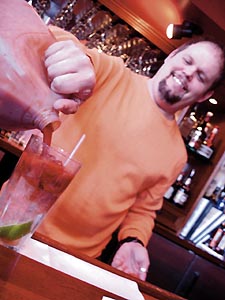 |
”We were one of the only ones left down here, other than Trio’s,” Annie remembers. ”People wouldn’t cross Q Street at that period…. When the riots started, they stormed 17th Street.”
Though Leigh Ann Hendricks has been working at Annie’s just a bit more than a decade, she’s been part of the Annie’s community longer than that. And as manager, she recounts the history as well as the old-timers.
”That’s when the gay community made this area gay,” says Hendricks.
Annie is quick to jump in: ”That’s when they claimed it.”
Continues Hendricks: ”No one else would come over here. This was bad. Along the [17th Street] strip, businesses had their windows broken out…. The gay community, they still came here. They continued to come here because this is where they felt comfortable. This is where they could be themselves. They said, ‘Riots aren’t going to keep us out. This is our place. This is where we like to go.”’
While the gay community kept Annie’s alive during the economic downturn that followed the riots, it was at this time that George Katinas bought the building that he would eventually combine with his butchering site to become today’s Annie’s Paramount Steakhouse.
Adding to the positive changes, depending on one’s perspective, Annie hired her first male waiters in this period. Mano, who goes by the single name alone, was the first in 1974.
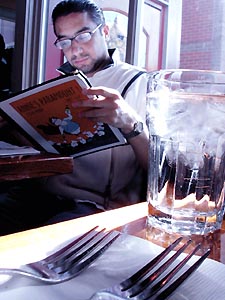 |
”We put him on the front patio,” says Annie. “At the beginning, the gays didn’t like gay waiters. It was very scary to them for some reason. They liked the mother image, I guess. Gradually, it changed.”
Mano doesn’t remember it quite the same way. As far as he’s concerned, at 26, he was the star of the patio. ”The customers loved it,” he says with pride. ”I was young and pretty. Now I’m old and handsome.”
The local gay community, no doubt invigorated by the June 1969 Stonewall riots in New York City, continued to evolve through the ’70s with newfound pride. Annie’s evolved along with them, moving into the current location in 1985 with no interruption in service. They closed Saturday night at 1519 17th Street NW, and opened the next morning a block north. As the restaurant experienced healthy growth, however, its clients were facing a deadly epidemic.
”We lost a lot of customers,” says Annie. ”It got kind of jittery. People got scared. We did lose a lot of waiters, a lot of friends. HIV became very obvious, but people kept it quiet if they had it. Then some night they’d have a few drinks at the bar and start crying, and they’d tell us. We lost a lot of nice boys. It was very difficult.”
Through the years, HIV/AIDS has continued to leave its menacing mark on the city’s gay community. Still, the lowest single point at Annie’s was yet to come. Early Monday morning, Aug. 23, 2004, Adrien Alstad, a waiter at the restaurant for more than 15 years, was walking home after closing the Sunday night shift. He said goodnight to co-worker J.J. Engbert after walking her to her truck at 18th and R streets. Refusing her offer of a ride, he continued the few blocks to his own home. But he didn’t make it. He was shot and killed just steps from where he said goodnight to Engbert.
”We’re still not recovered,” says Hendricks, pointing to the framed photo of Alstad that resides above the bar. ”Anytime ‘Dancing Queen’ came on, he would stop what he was doing, come out to the dining room, and start singing and clapping his hands. He would get everyone in the dining room to start singing.”
”Everyone remembers him,” adds Annie. “Adrien was a wonderful person, very intelligent. He could’ve had any job he wanted, but he chose to be a waiter because he wanted to be free to be who he really was. He enjoyed his work.”
Happy Days, 2006
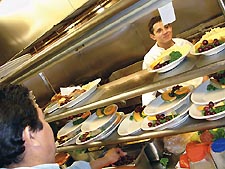 |
Outside, it’s sunny and chilly. Inside, the front door alcove is packed with people waiting for tables. Some women in the corner are having a raucous time, and getting their photo taken. A table of fantastically well-dressed, older black gentlemen is making everyone else look just a little bit shabbier — though the effect is surely not intentional. Some fixate on newspapers, some concentrate on their plates, while the Bloody Marys are flowing. It’s difficult to find an entire minute that doesn’t include the sound of at least one person laughing. Brunch is a busy time at Annie’s. And the demographics are impossible to pin down. Hendricks estimates that up to 70 percent of Annie’s clientele are customers who eat at the restaurant weekly. Those regulars include every letter in the GLBTQI rainbow — and straight people to boot.
”A lot of our regulars — our older ones — grew up with Annie,” says Hendricks of the strong bonds built at the restaurant. ”They were young when she was young. They all became friends.”
Adds Annie, ”A lot of our regulars moved to Florida, but they visit. We’re developing new faces. That’s what we want. The new faces, they learn to appreciate the place…. We’ve got young people who go the bar, who are maybe not gay, and they love it here because it’s so friendly. A lot of places you can go into and no one talks to you. I think that has a lot to do with it. If you come in here, you’re not going to feel unwanted.”
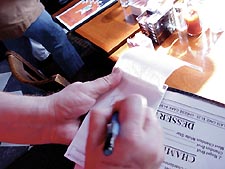 |
Take Bob, for example. The 81-year-old retiree may be uncomfortable using his last name — an impulse that comes from decades of secretive government work that required he keep the closet door shut — but he seems awfully comfortable sliding into his regular table at Annie’s once or twice a week. He says he’s been an Annie’s patron for 15 years, ever since he bought his condo in the neighborhood. Staff call him by name, and his Manhattan arrives before he asks for it.
Non-smoking Bob has chosen his booth in the smoking section by the front door. He usually gets it. ”It’s away from the smoke, and not near the back,” he says, looking at the passing parade on the sidewalk. ”And I like the view. I don’t come here because I’m gay, but because of the great food. That’s what’s so good.” Bob adds that he’s fond of the $4.50 Manhattan as well, chiding other bars for charging $8 or more.
His attitude is also right at home. ”I just don’t think people should take themselves too seriously. We have a good time here. It’s fun here.”
While Annie’s is a retirement treat for Bob, Jeff Coles, 34, started visiting Annie’s before his career began. He’s been coming to Annie’s for 10 years, he reckons. His first visits were when he’d come up from Roanoke to visit friends. Now, he and his partner, Phil Tavolacci, 33, are regular patrons. They visit Annie’s, says Tavolacci, ”too much. Way too much. It’s how we got fat. We come once or twice a week.”
In reality the two are about as fat as Annie is stuffy. Still, Coles claims a weakness for the restaurant’s fried shrimp. Tavolacci is partial to the Crab Imperial and Athenian Chicken.
Enjoying Sunday brunch, Coles says they’re pretty familiar with the staff, but they haven’t quite crossed into first-name basis. ”They don’t know our names, but they know our faces.”
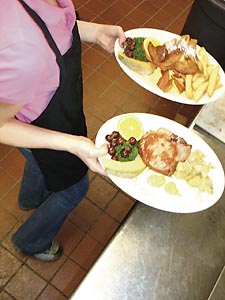 |
The staff know Larry King’s name, but they choose not to use it. Instead, he’s ”La King,” a play on the way his name appears on his credit card receipts. King says he’s been coming to Annie’s since the 1970s.
”They were on 17th Street when it wasn’t a very nice place. It was scary to walk down the street,” he says, also remembering the time when Annie manned one side of the bar and Sue, the other, each creating her own ambience. ”Annie’s side was always a mess!” he laughs, admitting that he always sat on Annie’s side.
About a year ago, King’s sister, Kay, finally insisted that she wanted in on the fun.
”Larry talked about Annie’s like it was so much fun,” Kay says. ”About 52 visits later, I’m hooked. It’s just a good time, like a social group. We come here right after church. If we miss church, we’ll have the service here.”
That’s the sort of religious devotion Annie herself maintains, still coming to the restaurant about twice a week. Mostly, she says, she just sort of holds court. On occasion, she’ll whip up some Manhattans. For those who haven’t seen her in action, bartender Marco Mollay has immortalized her pouring out her signature batch. The portrait hangs in the stairwell at the back of the restaurant. It also graces the cover of the menu.
But just as Annie behind the bar becomes an infrequent scene at the steakhouse, other changes may be afoot.
”Tastes are getting healthier. Some people are asking for more salads,” says Hendricks, who points to an already decent selection. Annie adds they’ve even got hot dogs to accommodate an increasing number of kids in the restaurant. But with a formula that obviously works, with more than half a century in business as evidence, there’s not much point in tinkering with success. Even if the vast menu — from ”Annie’s Homemade Crab Cakes” to the ”zucchini stix” — faces some changes, the attitude is not about to budge.
As Mano puts it, ”I’ve never had an unhappy moment at this place. Not one. That’s the beauty of this place.” He also offers that no matter who comes through the door, Annie’s will always be gay. ”’Gay’ means happy. ‘Gay’ means family. That’s ‘gay.”’
And that’s Annie’s Paramount Steakhouse.
Annie’s Paramount Steakhouse is located at 1609 17th St. NW. The restaurant will be donating 50% of its March 9th dinner receipts to Dining Out for Life.
Support Metro Weekly’s Journalism
These are challenging times for news organizations. And yet it’s crucial we stay active and provide vital resources and information to both our local readers and the world. So won’t you please take a moment and consider supporting Metro Weekly with a membership? For as little as $5 a month, you can help ensure Metro Weekly magazine and MetroWeekly.com remain free, viable resources as we provide the best, most diverse, culturally-resonant LGBTQ coverage in both the D.C. region and around the world. Memberships come with exclusive perks and discounts, your own personal digital delivery of each week’s magazine (and an archive), access to our Member's Lounge when it launches this fall, and exclusive members-only items like Metro Weekly Membership Mugs and Tote Bags! Check out all our membership levels here and please join us today!


















